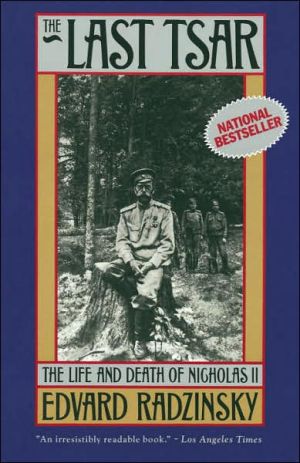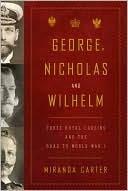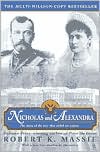The Last Tsar: The Life And Death Of Nicholas II
Russian playwright and historian Radzinsky mines sources never before available to create a fascinating portrait of the monarch, and a minute-by-minute account of his terrifying last days. Updated For The Paperback Edition.
Search in google:
Russian playwright and historian Radzinsky mines sources never before available to create a fascinating portrait of the monarch, and a minute-by-minute account of his terrifying last days. Updated For The Paperback Edition. Publishers Weekly Historians have long believed that Lenin personally ordered the murder of Czar Nicholas II and his family in July 1918; this contradicts the official Soviet version, in which Siberian Bolsheviks ordered the executions without Moscow's clearance. Radzinsky, a Russian playwright, adds many valuable pieces to the jigsaw puzzle in an hour-by-hour reconstruction of the slaying, based on royal diaries and newly uncovered eyewitness accounts from the executioners. The author unearthed the testimony of Lenin's bodyguard, who said that Lenin had ordered him to destroy a secret telegram (and its transmittal ribbon), which contained the top Bolshevik's order to carry out the executions. Oral testimony by a soldier who participated in the killings, given decades later to an informant whom Radzinsky interviewed, alleges that two bodies were missing from the truck that took the executed royal family to an unmarked grave; this will fuel speculation that Anastasia and Alexei, heir to the throne, survived the fatal night. Using the diaries of Czar Nicholas and Empress Alexandra, Radzinsky also presents a fragmentary account of Romanov family life, their kidnapping and the abortive plots to save them. Photos. (July)
AcknowledgmentsPrologue1Pt. ILeafing Through the Tsar's Diaries5Prelude: From the Archive of Blood71Diary of the Young Man112Diary of the New Tsar433Dress Rehearsal for the Collapse of His Empire744A Mighty Pair955The Tsar's Family1116Diary of the Successful Monarch1197A Novel in Letters132Pt. IIThe Death of Nicholas and Alexandra1678The Fall of Atlantis1699The Prisoner's Siberian Diary21010Comrades23411Secret Mission25512The Last House28513Flight31614Preparations for Murder333Pt. IIIThe Secret of the Ipatiev Night34915The Investigation Begins35116My Guest394Epilogue: Participants in the Execution (Fates)425Afterword (New Mysteries?)433Appendix439Selected Bibliography445Photo Credits451Index453
\ Publishers Weekly - Publisher's Weekly\ Historians have long believed that Lenin personally ordered the murder of Czar Nicholas II and his family in July 1918; this contradicts the official Soviet version, in which Siberian Bolsheviks ordered the executions without Moscow's clearance. Radzinsky, a Russian playwright, adds many valuable pieces to the jigsaw puzzle in an hour-by-hour reconstruction of the slaying, based on royal diaries and newly uncovered eyewitness accounts from the executioners. The author unearthed the testimony of Lenin's bodyguard, who said that Lenin had ordered him to destroy a secret telegram (and its transmittal ribbon), which contained the top Bolshevik's order to carry out the executions. Oral testimony by a soldier who participated in the killings, given decades later to an informant whom Radzinsky interviewed, alleges that two bodies were missing from the truck that took the executed royal family to an unmarked grave; this will fuel speculation that Anastasia and Alexei, heir to the throne, survived the fatal night. Using the diaries of Czar Nicholas and Empress Alexandra, Radzinsky also presents a fragmentary account of Romanov family life, their kidnapping and the abortive plots to save them. Photos. (July)\ \ \ \ \ Library JournalA prominent Russian playwright has turned his talents to historical investigation and produced an account containing intriguing new details for the Western reader and revelations for the previously uninformed citizenry of the former Soviet Union. Long fascinated by the death of Nicholas II, his wife, and his children, Radzinsky gained access to long-closed national archives containing state documents, diaries of the tsar and his family, and eyewitness accounts. To the well-known fact that the Bolsheviks who held the royal family executed them hastily out of fear that advancing White forces might recover the tsar, Radzinsky adds documentation of Lenin's approval of the local Reds' actions and full descriptions (from participant accounts) of the killings and disposal of the bodies. He also introduces evidence suggesting that two of the Romanovs survived. Early chapters are routine, and a trained historian might have handled the material differently, but this book will attract attention. For most collections.-- Rena Fowler, Northern Michigan Univ. Lib., Marquette\ \ \ Kirkus ReviewsOn July 17, 1918, Nicholas II—the last tsar in the 300-year- old Romanov dynasty—and his wife, five children, family doctor, and three servants were executed in the storage room of a squalid house in a small Siberian city, their bodies burned, then buried in a mine shaft. From previously hidden royal diaries and letters, the testimony of the executioners, and the reminiscences of friends and descendants, Radzinsky, a popular Russian playwright, dramatizes the Romanovs' final, poignant days—the confusion, mystery, and waste. Radzinsky begins by re-creating the personalities and events of happier times: Nicholas, doting, charming, ineffectual; "Little Wifey," as he called his empress, the half-mad, superstitious, demanding granddaughter of Queen Victoria; the four daughters, dressed in white; the hemophiliac son, beloved but bored; the demonic Rasputin; and the clutch of cousins and generals who secluded the royal family from the popular unrest, terrorism, and war that marked Nicholas's reign. Radzinsky's dramatic technique of weaving together scraps from the family's diaries and letters is particularly effective in the book's second half. There, he follows the Romanovs through their final year after Nicholas's abdication, a year during which the family—waiting to be rescued by the tsar's English cousin, King George, or to seek refuge in a monastery—was dragged around the countryside by unlettered Bolshevik guards until Lenin himself, deciding on the "simple" and "ingenious" solution to the Romanovs' fate, gave the order for their execution, recounted here in brutal detail. Like James Blair Lovell in Anastasia (1991), Radzinsky incorporates into his storyhis own pursuit of historical truth, sharing his frustrations and fascinations; and he confirms what Lovell demonstrated—that the Romanovs tend to inspire exceptional writing, lyrical, precise, and intense. (Fifty b&w photographs—not seen.)\ \








